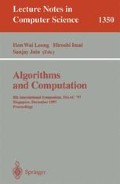Abstract
Let G = (X, Y, E) be a bipartite graph with integer weights on the edges. Let n, m, and N denote the vertex count, the edge count, and an upper bound on the absolute values of edge weights of G, respectively. For a vertex u in G, let G u denote the graph formed by deleting u from G. The all-cavity maximum matching problem asks for a maximum weight matching in G u for all u in G. This problem finds applications in optimal tree algorithms for computational biology. We show that the problem is solvable in O(√nmlog(nN)) time, matching the currently best time complexity for merely computing a single maximum weight matching in G. We also give an algorithm for a generalization of the problem where both a vertex from X and one from Y can be deleted. The running time is O(n 21og n + nm). Our algorithms are based on novel linear-time reductions among problems of computing shortest paths and all-cavity maximum matchings.
Research supported in part by NSF Grants CCR-9531028.
Research supported in part by RGC (The Research Grants Council of Hong Kong) Grants 338/065/0027 and 338/065/0028.
Preview
Unable to display preview. Download preview PDF.
References
R. E. Bellman. On a routing problem. Quarterly of Applied Mathematics, 16:87–90, 1958.
D. P. Bertsekas. The auction algorithm: A distributed relaxation method for the assignment problem. LIDS Report P-1653, Massachusetts Institute of Technology, Cambridge, MA, 1987.
T. H. Cormen, C. L. Leiserson, and R. L. Rivest. Introduction to Algorithms. MIT Press, Cambridge, MA, 1991.
N. Deo and C. Pang. Shortest-path algorithms: Taxonomy and annotation. Networks, 14:275–323, 1984.
R. W. Floyd. Algorithm 97: Shortest path. Communications of the ACM, 5:345, 1962.
L. R. Ford and D. R. Fulkerson. Flows in Networks. Princeton University Press, Princeton, NJ, 1962.
M. L. Fredman and R. E. Tarjan. Fibonacci heaps and their uses in improved network optimization algorithms. Journal of the ACM, 34:596–615, 1987.
H. N. Gabow. Scaling algorithms for network problems. Journal of Computer and System Sciences, 31:148–168, 1985.
H. N. Gabow and R. E. Tarjan. Faster scaling algorithms for network problems. SIAM Journal on Computing, 18:1013–1036, 1989.
H. N. Gabow and R. E. Tarjan. Faster scaling. algorithms for general graphmatching problems. Journal of the ACM, 38:815–853, 1991.
A. V. Goldberg. Scaling algorithms for the shortest paths problem. SIAM Journal on Computing, 24:494–504, 1995.
A. V. Goldberg and R. E. Tarjan. Solving minimum-cost flow problems by successive approximation. In Proceedings of the 19th Annual ACM Symposium on Theory of Computing, pages 7–18, 1987.
J. E. Hopcroft and R. M. Karp. An n 5/2 algorithm for maximum matching in bipartite graphs. SIAM Journal on Computing, 2:225–231, 1973.
D. B. Johnson. Efficient algorithms for shortest paths in sparse networks. Journal of the ACM, 24:1–13, 1977.
M. Y. Kao, T. W. Lam, T. M. Przytycka, W. K. Sung, and H. F. Ting. General techniques for comparing unrooted evolutionary trees. In Proceedings of the 29th Annual ACM Symposium on Theory of Computing, pages 54–65, 1997.
D. R. Karger, D. Koller, and S. J. Phillips. Finding the hidden path: Time bounds for all-pairs shortest paths. SIAM Journal on Computing, 22:1199–1217, 1993.
Author information
Authors and Affiliations
Editor information
Rights and permissions
Copyright information
© 1997 Springer-Verlag Berlin Heidelberg
About this paper
Cite this paper
Kao, MY., Lam, T.W., Sung, W.K., Ting, H.F. (1997). All-cavity maximum matchings. In: Leong, H.W., Imai, H., Jain, S. (eds) Algorithms and Computation. ISAAC 1997. Lecture Notes in Computer Science, vol 1350. Springer, Berlin, Heidelberg. https://doi.org/10.1007/3-540-63890-3_39
Download citation
DOI: https://doi.org/10.1007/3-540-63890-3_39
Published:
Publisher Name: Springer, Berlin, Heidelberg
Print ISBN: 978-3-540-63890-2
Online ISBN: 978-3-540-69662-9
eBook Packages: Springer Book Archive

